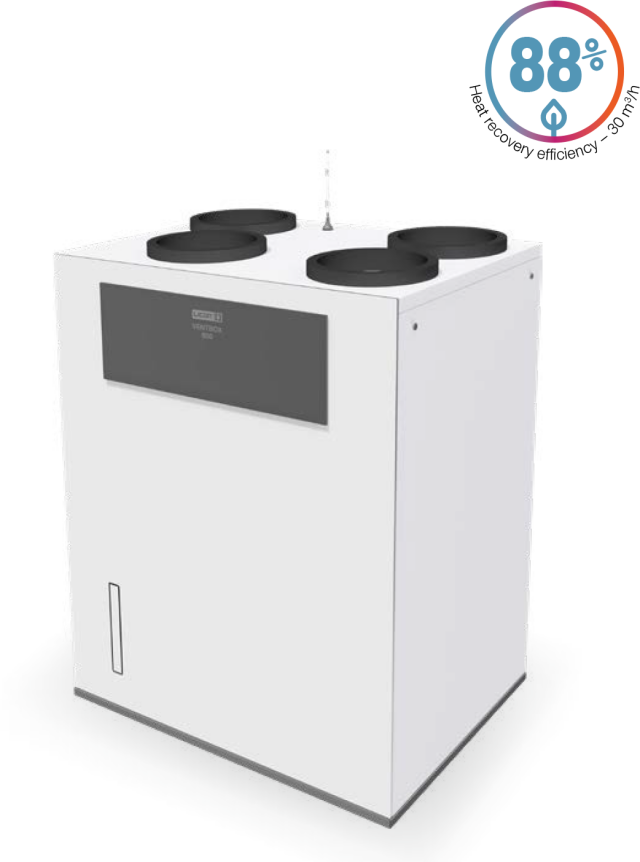VENTBOX 800
Public buildings and family houses up to 600 m²
The VENTBOX 800 central heat recovery unit provides controlled ventilation with air recovery and also serves as an effective tool for perfect filtration and removal of dust and various allergens from fresh incoming air. The heat recuperation unit also contributes to improvement of the building thermal performance. The use of sensors makes it possible to effectively ventilate radon, control CO2 levels, or remove excessive moisture building in the house. This version is one of the
most efficient ventilators on the market with the A+ energy class.
- Premium Version
The unit is equipped with unique EC motors with constant flow function. These unique motors compensate for pressure losses when the supply air flow is reduced, e.g. when the air filters become clogged. With these premium EC motors, the unit can operate more efficiently and economically; which positively affects the overall dynamics and also the economy of the heat recovery system use. The unit is provided with frost protection, and performance setting according to the current need and temperature. The unit is also equipped with an automatic by-pass function, where it compares the temperature of the indoor and outdoor air and switches on the bypass damper as required. This prevents the outdoor air from being heated by the exhaust air. The heat recovery unit can also be remotely controlled and operated via a web interface from a computer, smartphone, or tablet connected to the local network in the house.
- Fresh air without allergens and pollen
- Possibility of intensive extraction
- Radon-free house
| Recommended area | up to 600 m² | |
| Energy class | A+ | |
| Installation option | Floor mounting, wall mounting right variant | |
| Dimensions (h × w × d) | 1270 x 1005 x 740 mm | |
| Weight [kg] | 112 kg | |
| Voltage | 230 V AC/50 Hz | |
| Electric current without preheating [A] | 1.5 A | |
| Electric current including preheating [A] | 12 A | |
| Max. input power of the unit without preheating [W] | 318 W | |
| Max. preheating input power [W] | 2 550 W | |
| Total power consumption [W] | 2 868 W | |
| IP coverage | 30 | |
| Air flow [m³/h] | 120–800 m³/h | |
| Maximum airflow in BOOST setting [m³/h] | 800 m³/h | |
| Reference air flow [m³/h] | 560 m³/h | |
| Displacement pressure [Pa] | 50–200 Pa | |
| Acoustic energy LWA [m³/h/Pa/dB] | 560 m³/h/50 Pa/49 dB | |
| Heat transfer efficiency / Flow rate | 82 %/800 m³/h; 82 %/560 m³/h; 81 %/120 m³/h | |
| Electrical input (without preheating) | 263 W/800 m³/h; 105 W/560 m³/h; 20 W/120 m³/h | |
| ∅ of the connection necks [mm] | 250 mm | |
| Type of pipe for condensate drainage | HT DN 32 mm | |
| Specific power consumption SPI* W/m³/h | 0,19 W/at reference airflow 560 m³/h and disposition pressure of 50 Pa | |
| Max. number of all sensors (CO2 / RH / RADON …) | 9 | |
| Connector for fire sensor or EPS connection | Yes | |
| Automatic frost protection | Yes | |
| Bypass function (exchanger bypass) | Yes | |
| Shock ventilation | Yes | |
| Weekly time mode | Yes | |
| Measuring energy consumption | Yes | |
| Modbus TCP/IP communication | Yes | |
| Modbus RTU communication | Yes | |
| Analogue input | 2 | |
| Digital input | 1 | |
| EC motors with a constant flow function | Yes | |
| Filter clogging indicator based on time interval | Yes | |
| Wire pre-filter | Yes | |
| Filter clogging indicator based on filter pressure drop | Yes | |
| Filters supply//exhaust (% of particles captured in a given filter class) | F7 pollen/odour ePM1 70 % (F7 odour optional) | |
| By default, the unit is supplied with a counterflow heat exchanger (HRV) | ||
ORDERING CODES
Example of ordering code: VB1-0800-BC-PHR
First generation VENTBOX 800 unit for central air distribution, EC constant flow motors Premium version, with standard counterflow plate heat exchanger and right-hand connection.
| VENTBOX | Generation | | Volume flow | | Design | Heat recovery unit type | | Model / Type | Exchanger type | Connection option |
|---|---|---|---|---|---|---|---|---|---|---|
| V B | 1 | - | 0800 | - | B | C | - | P | H | R |
| | | | | | Box | Centralized | | P - Premium | H - standard E - enthalpy | R - right |
Contact us
For more information, do not hesitate to contact us
